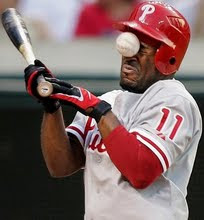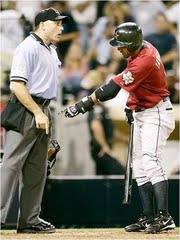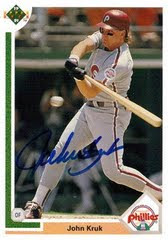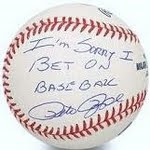The 2006 season was a breakout year for Rios, however. Over a mere 128 games played (he was slowed down after the All-Star Break due to a ball he fouled off his foot that led to his hospitalization), Rios slashed .302/.349/.516 (.865 OPS) with elite defense (+9.6 FRAR).
Though still somewhat allergic to walks (7.0 percent walk rate), Rios batted in 82 men, while showing a good balance of power (17 HR, .213 ISO) and speed (15 SB, 6.2 speed score). Before his foul-ball injury, Rios' season looked even brighter, batting .359 with 43 RBI and most of his homers (11) through his first 60 games played.
Recovered from his foot folly, Rios followed up his quality 2006 campaign with even better fantasy numbers in 2007 and 2008, batting a combined .294/.343/.480 (.823 OPS). His power (39 HR) and speed (49 SB) blend remained tantalizing, while he racked up 150 RBI and 205 rusn to boot and acted as a model of health (316 combined games played out of a possible 324). Rios' 2006-2008 performance was rewarded by then-General Manager J.P. Riccardi, who gave him the contract we all associate him with today.
Rios had broken out by 2009, but there were some signs that, heading into his age 28 season, Rios, for all his enchantment, was not infallible. For one thing, despite Rios' strong clipping (20.5 percent career line-drive percentage heading into 2009), he remained immune to ball four. Through his first five seasons in the majors (2875 plate appearances), Rios had only drawn 186 walks on his own merit (BB-IBB), for a sub-par 6.5 percent walk rate.
Rios showed some improvement in 2006 (7.0 percent) and 2007 (7.7 percent), but took a large step back in 2008 (6.4 percent) that he would never undo. For a sense of comparison, the major league average walk rate between 2004 and 2008 fluctuated between 8.2 percent and 8.7 percent.
Despite a low strikeout rate that was seemingly improving and settling in around the upper teens between 2004 and 2008, Rios' strikeout-to-walk ratio remained sub-par. The major league average K:BB rate for hitters is around 2:1, but Rios only touched that mark once, in 2007, floating around just under 3:1 the rest of his major league seasons (including 2008).
Rios' sleek wheels (93 stolen bases between 2004 and 2008) were also not as pretty as many analysts pegged them to be. Rios had only eclipsed the 15 stolen base mark in two of his five major league seasons (17 in 2007 and a career-high 32 in 2008). Double-digit stolen bases are always nice, but for as great as Rios' speed was touted (mid-6s speed score), the results rarely materialized in the form of fantasy gold.
Furthermore, and far more worrisome, were the 30 times Rios
Still, Rios was a pull-hitter in one of baseball's coziest places for right-handed batters (just ask Jose Bautista, who has hit 41 of his past 70 homers there). His strong batting average between 2006 and 2008, paired with his 24 home runs from 2007 and 32 stolen bases from 2008, gave promise of a .300/20/20 campaign with .300/25/30 upside in the near future.
But then things started to fall apart.
Rios, a consensus top-50 pick of 2009, batted .264/.317/.427 over the first 108 games of the season for the Blue Jays. He continued to steal bases (19 over his first 108 games), but his ISO trended downwards for the third consecutive season. He continued to pray to a Dunn-hating J.P. Riccardi (6.5 percent walk rate), and though his line drive rate was not poor (18.1 percent on the Jays), it represented a career low that further manifested itself in a career-worst BABIP (.289 through his first 108 games played).
Rios was placed on waivers and given away wholesale—for nothing more than salary relief—to the White Sox in mid-2009, and he has resided there ever since. Kenny Williams hoped a change of scenery would be all that Rios needed to return to his glorious 2006-2008 status. I was incredibly, and probably overly, critical of the move at the time.
I did not understand fielding metric sample size requirements at the time, and rather than seeing a major league-average hitter with strong outfield defense capable of posting 3.0-plus WAR seasons, I saw a squandering of cash being thrown at Rios.
For the sake of my credibility, Rios did exactly what I predicted him to do over the final two months of the 2009 season with the White Sox, posting an atrocious .199/.229/.301 line over his final 41 games. Rios stole five bases for the Pale Hose, but he was caught twice. He also only had three home runs to go along with an Erstad-ian .103 ISO.
I continued to hate on Rios in the early offseason (culminating in an infamous radio argument with a certain White Sox post-game announcer over whether Jayson Nix, at the major league minimum, would have been a better player for the Sox than Alex Rios, an argument that persists between the two of us to this day, immortalized on Twitter), but I made amends in March of 2010, pegging Rios as a post-hype sleeper bargain (his preseason rank was No. 141 on Yahoo) for the upcoming season.
In some sense, my analysis of Rios was again dead on. I claimed Rios would hit somewhere in the ballpark of .286/.331/.443 with 20 home runs and 30 stolen bases. His end of season line was in fact .284/.334/.457 with 21 home runs and 34 stolen bases.
Still, for all the good Rios did by the end of the year, almost all of that performance came in the first half of the season. I pegged Rios' second half as the universe balancing out of the type of luck he experienced in the first half (no, I do not believe in the gambler's fallacy), but I should have looked at his numbers in US Cellular field a bit more closely before I ranked him as my No. 12 overall outfielder heading into the 2011 season.
Take a gander at Rios' numbers by month on the White Sox, and pay particular attention to his wRC+, which measures his relative batting value to the rest of the league adjusted for park/league:
| Month | AVG | OBP | SLG | BABIP | BB/K | ISO | wOBA | wRC+ |
| Aug 09 | 0.210 | 0.221 | 0.383 | 0.241 | 0.09 | 0.173 | 0.254 | 44 |
| Sept/Oct 0 | 0.211 | 0.253 | 0.300 | 0.227 | 0.38 | 0.089 | 0.246 | 38 |
| Mar/Apr 10 | 0.277 | 0.326 | 0.470 | 0.294 | 0.50 | 0.193 | 0.356 | 118 |
| May 10 | 0.344 | 0.406 | 0.700 | 0.311 | 1.00 | 0.356 | 0.471 | 196 |
| Jun 10 | 0.297 | 0.355 | 0.406 | 0.346 | 0.33 | 0.109 | 0.330 | 99 |
| Jul 10 | 0.293 | 0.321 | 0.414 | 0.317 | 0.28 | 0.121 | 0.310 | 86 |
| Aug 10 | 0.261 | 0.303 | 0.409 | 0.297 | 0.29 | 0.148 | 0.313 | 89 |
| Sept/Oct 1 | 0.228 | 0.291 | 0.354 | 0.258 | 0.40 | 0.127 | 0.297 | 78 |
| Mar/Apr 11 | 0.163 | 0.245 | 0.235 | 0.181 | 0.67 | 0.071 | 0.228 | 34 |
| May 11 | 0.268 | 0.305 | 0.411 | 0.271 | 0.50 | 0.143 | 0.305 | 88 |
| TOTALS | 0.255 | 0.305 | 0.403 | 0.276 | 0.40 | 0.148 | 0.311 | 87 |
Notice that with the exception of April and May of 2010, Rios has been a below-average major league hitter in each of the months he has played for the White Sox. Sure, he was league average in June 2010, but if that's the kind of upside he is providing fantasy owners and White Sox fans alike, then perhaps he does not warrant either the $12 million per year Kenny Williams is paying him or the $20-plus you shelled out to get him on draft day.
In my Ottoneu league, Rios went to an owner for $1 courtesy of a programming glitch we were to lazy to fix. That seemed like a steal of a deal, but one quarter of the way through 2011, his .201/.266/.299 line, with three homers and four stolen bases (with three caught stealing) is hardly looking like a bargain (especially in comparison to my $2 Carlos Quentin).
So what do you do? In light of this data, do you jump ship, ride it out, or "buy low?"
On the bright side, Rios' xBABIP with the White Sox is .328. His actual BABIP on the team has been .276. With less than 1000 plate appearances in a black-and-white jersey, it is very possible that Rios is on an extended cold streak. If you adjust his White Sox batting line of .255/.305/.403 to reflect his xBABIP, you'll find his expected triple-slash line improves to .297/.340/.445. That neatly reflects his 2006-2008 overall performance level.
Furthermore, the move from Rogers Center to U.S. Cellular Field is far from a move to spacious Petco Park for a left-handed batter. Whereas Rogers Center has a right-handed batter index of 116 for home runs and 97 for batting average, the south side bandbox has respective indicies of 145 and 98.
In other words, the two parks have relatively equal expected effects on batting average for righties, while Rios' new home is a 20 percent more favorable environment for going deep. U.S. Cellular Field, in fact, has the highest right-handed batter home run index of any park in the major leagues, with Great American Ballpark a distant second at 125.
If anything, this is an argument is favor of Rios' 20-home run capability, while his three home runs and four steals to date say that a 15/15 or better campaign, even with Rios' struggling, is well in the cards.
On the negative, however, Rios is now 30 years old, and he's not getting any younger. Players tend to peak in their mid-20s, plateau through about age 30, and then decline in ability. Rios may simply be on the downside of a productive fantasy career.
His .097 ISO on the season is far away from stabilizing (we need at least 550 plate appearances to start drawing conclusions with respect to power), but if you take April and May of 2010 out of the equation, Rios' power on the White Sox has been more of an outage than a surge. At some point, a player isn't just having bad luck; he could simply be coming apart at the seems.
Still, Rios is only 30. If he was a couple of years older, perhaps I would be more skeptical, but I have faith that Rios will bounce back somewhat this season and end the year with 15 or so home runs and 20 stolen bases, hitting .280 the rest of the way. That's not bad, but, especially if the White Sox keep Rios in the bottom dregs of their lineup, it's hardly going to end up being what you expected and paid for on draft day. Oliver expects Rios to hit .267/.318/.429 the rest of the way, and to end the season with 18 home runs and 22 stolen bases.
There is probably someone out there willing to take a gamble on an "established" player like Rios, thinking there is plenty of upside left in the tank. Trading Rios is very possible if you are either tired of his early season struggles (a terrible reason to sell) or think you can get more value in return than what he is worth to you or what you think he can do.
Just don't go selling off for 70 cents on the dollar, because a 15-20/20-25 rest of season pace with a average-or-better fantasy batting average is not easy to come by on the waiver wire, especially in deeper formats.
At the very beginning of May, a frustrated Mike Stanton owner offered me a straight-up swap for Rios. I pounced and have not looked back; with Stanton's May surge, I doubt you can get the same deal done at this point, but swapping out Rios for a player like Hunter Pence or Jason Heyward might be possible, and I would personally make either deal.
I can't say I would give the same advice to Kenny Williams, however.
What would you do, or have you done, with Alex Rios? As always, leave the love/hate in the comments below.







0 comments:
Post a Comment